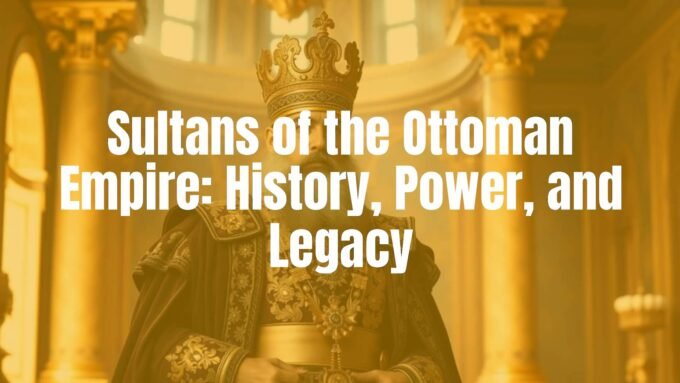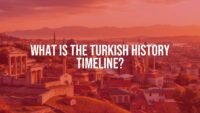The Turkish history timeline covers more than 4,000 years across the lands of today’s Turkey. Because this area sits between Europe, Asia, and Africa, many peoples and empires met, traded, fought, and moved through it over thousands of years.
From the first settlements in Anatolia to the modern Republic, the story is one of steady change in politics, society, and culture. Ancient groups set early roots, strong empires fought for control, and a clear national identity later formed. That identity still affects regional and global affairs today.
Key Periods and Turning Points Across Centuries
Turkey’s past can be grouped into broad eras: prehistoric Anatolia; ancient empires with Hellenistic and Roman rule; the Byzantine period; the arrival of Turkic peoples; the Seljuks; the Ottomans; and the Republic. Each era left clear marks on the land and its people.
| Period | Dates (approx.) | Highlights |
|---|---|---|
| Prehistory & Bronze Age | to 2000 BCE | Early farming, cities like Çatalhöyük, sites like Göbekli Tepe |
| Hittites & Iron Age states | 2000-500 BCE | Hittite Empire, Phrygia, Urartu, Lydia |
| Persian & Hellenistic | 545-30 BCE | Persian satrapies; Alexander’s conquests and Greek culture |
| Roman & Byzantine | 129 BCE-1453 CE | Province of Asia; spread of Christianity; capital at Constantinople |
| Seljuks & Turks | 11th-13th c. | Manzikert (1071); Sultanate of Rum |
| Ottoman Empire | 1299-1922 | Expansion, peak under Suleiman, decline and WWI |
| Republic of Turkey | 1923-present | Atatürk’s reforms, multi-party politics, 21st-century shifts |
Each era brought its own mix of culture, government, and technology. Learning this timeline is more than memorizing dates; it helps explain the many layers that make up Turkey today.

Prehistoric Anatolia: Early Civilizations to Bronze Age
Anatolia, which covers most of modern Turkey, has very old human roots, reaching back over a million years. This land, close to the Fertile Crescent, saw early farming and the rise of complex communities long before many other places.
Clues come from stone tools, cave art, and the remains of homes and towns. They show how early people adapted, built, and shared skills across generations.
Paleolithic and Neolithic Settlements
- Paleolithic (about 60,000-10,000 BCE; with evidence up to 1.2 million years ago): tools near the Gediz River; cave finds near Istanbul and Antalya, including animal bones and wall art.
- Mesolithic (10,000-8,500 BCE): continued coastal sites along the Mediterranean, more cave art and tools.
- Neolithic (8,500-5,000 BCE): start of farming and herding in the southeast; permanent villages grow.
Çatalhöyük in south-central Turkey shows advanced town planning, farm tools, animal care (including dogs), and religious items like female figurines. Other key sites include:
- Göbekli Tepe: a temple complex about 12,000 years old.
- Alaca Höyük: evidence of early organized life in Anatolia.
Chalcolithic and Bronze Age Cultures
In the Chalcolithic (5,000-3,000 BCE), people began using copper tools. Rich mineral resources helped early metalwork spread across Anatolia.
In the Bronze Age (3,000-2,000 BCE), bronze tools and weapons became common. Finds near royal graves include metal objects, showing wide use of bronze. Trade with nearby regions grew, linking Anatolia to a larger network.
Major Ancient Societies: Hatti, Hurrians, and Troy
Near the end of the Bronze Age, new groups settled in Anatolia. The Hatti created small city-kingdoms in central Turkey (about 2,500-2,000 BCE). They spoke their own language and followed many gods. Trade with Assyrians led to Karum trading posts and brought cuneiform writing to the region, later used by Hittites too.
The Hurrians moved in from areas near the Caspian Sea. They often fought neighbors and had their own language and religions. In the northwest, Troy grew into a major port. Known from Homer’s Iliad, Troy was real and long-lived. Layers Troy II (2,500-2,000 BCE) and Troy VI (1,800-1,275 BCE) show growth, strong defenses, and trade with Greeks (seen in Mycenaean pottery). Troy VI likely fell to an earthquake around 1250 BCE, close to the wider Bronze Age collapse.
The Rise and Fall of Ancient Empires in Anatolia
Anatolia’s location put it in the middle of many empires’ plans. After the Bronze Age, powerful states rose and fell, each leaving clear cultural, building, and political marks. Borders shifted, wars were frequent, and new ways of ruling appeared.
The region mixed languages, religions, and systems of government as different powers took control, making it a busy and often contested crossroads.
Hittite Kingdom and Its Legacy
Around 2000 BCE, the Hittites, an Indo-European group, grew strong and absorbed earlier Hattian peoples. Their capital was Hattusa. From about 1750 to 1200 BCE, the Great Hittite Kingdom expanded and challenged other major powers. At Kadesh in 1274 BCE, they fought Egypt, leading to one of the first recorded peace treaties.
The Hittites worked iron and gained an advantage in tools and weapons. They built legal and diplomatic systems ahead of their time. Around 1180 BCE, their empire broke apart during the Late Bronze Age collapse, leaving smaller Neo-Hittite states.

Phrygia, Lydia, Caria, and Urartu Civilizations
After the Hittites, new Iron Age states rose (1200-700 BCE). Phrygia, in west-central Anatolia (about 750-300 BCE), drew on Greek and Hittite ideas. It was known for its roads and the myth of King Midas. Its central rule was weak, and after Midas’s death, it lost its freedom.
Urartu (900-600 BCE), around Lake Van, expanded to parts of today’s Armenia and Georgia and to the sources of the Tigris and Euphrates. Often attacked by Assyria, it still left strong fortresses and fine metalwork. Medes and Scythians ended Urartu in the 6th century BCE.
In western Anatolia (700-300 BCE), Lydia, Caria, and Lycia grew. Lydia, rich in gold and silver, likely introduced coinage under King Croesus. Its wealth invited conquest by Persia, then Greeks and Romans. Caria to the south sailed and traded with Greeks and Minoans. Lycia on the Teke peninsula built rock-cut tombs; over forty ancient cities are known there. These groups kept their own languages and older local traditions while also mixing with Greek culture.
Persian Rule and Classical Antiquity
From about 545 BCE, Cyrus the Great built the Achaemenid Persian Empire and took much of Anatolia. Under Persian rule (545-333 BCE), the land was split into satrapies under royal governors. Taxes were collected, and roads like the Great Royal Road from Susa to Sardis helped trade.
Ionian Greek cities on the coast rose up in the early 5th century BCE, feeding into the Greco-Persian Wars. Persia kept control for a time, but Alexander the Great arrived in 334 BCE, defeated Darius III, and took Anatolia, starting a new Hellenistic phase.
Hellenistic, Roman, and Byzantine Eras
After earlier empires faded, Anatolia entered the Hellenistic age, then Roman rule, and later the Byzantine period. New languages, faiths, and ways of ruling spread, and Anatolia became a key bridge between East and West.
The mix of cultures in these centuries set roots for later changes and linked Anatolia closely to wider regional history.
Hellenistic Age: Alexander the Great’s Influence
Alexander’s campaign in 334 BCE began the spread of Greek culture across Anatolia. After his death in 323 BCE, his generals split the empire, and smaller Hellenistic states formed. Greek language and customs spread through cities and colonies across the Near East, Middle East, North Africa, and Southwest Asia.
This period brought big steps in art, literature, music, math, philosophy (like Stoicism, Epicureanism, Pyrrhonism), building, and science, with figures such as Euclid and Archimedes. Anatolia stayed a busy crossroads. Over time, power shifted to Rome, and by the mid-1st century BCE, Hellenistic states in Anatolia became part of the Roman Republic.
Roman Province and the Spread of Christianity
By 129 BCE, Rome made Anatolia a province called Asia (Asia Minor), with Ephesus as its capital. Roman order and administration brought a long stretch of peace and trade. Roads and sea routes carried goods and ideas.
Christianity spread early in this period. Saint Paul of Tarsus used Roman roads to travel and write letters; some of the oldest Christian texts come from his work in Anatolia. Major church councils that shaped doctrine took place here:
- First Council of Nicaea (Iznik), 325 CE
- First Council of Constantinople, 381 CE
- Council of Ephesus, 431 CE
Byzantine Empire and Constantinople’s Role
In 330 CE, Emperor Constantine made Byzantion on the Bosphorus the capital of the Eastern Roman Empire. Renamed New Rome and later Constantinople (today’s Istanbul), it became the center of power for more than a thousand years.
After the Western Empire fell in 476 CE, the Eastern Empire, known as the Byzantine Empire, carried on. Christianity was made the state religion in 380 CE, and Constantinople remained the only capital. The Byzantines kept Roman identity but used Greek language and culture. They built great works like Hagia Sophia under Justinian I. The empire often fought the Sassanids and later lost rich lands to Muslim conquests, but it lasted until 1453, when the Ottomans took Constantinople.

Arrival and Expansion of the Turks in Anatolia
In the medieval era, Turkic peoples moved into Anatolia from Central Asia. They brought new languages, cultures, and Islam, which became the main faith in many areas. Over time, this movement changed the region’s people, politics, and culture.
Byzantine control faded in stages. Battles, migrations, and local rule by new Turkish states led to a steady change in who lived in and ruled Anatolia.
Early Turkic Peoples and Migrations
Early Turkic groups lived as nomads in parts of today’s China and Mongolia. Clear signs of distinct Turkic peoples appear around the Xiongnu borders by about 200 BCE. By 1000 CE, many Turkic groups who herded animals had adopted Islam.
The Göktürks in the 6th century CE united many nomadic tribes and formed the first state called “Turk.” They wrote Old Turkic in a runic script. Over time, Turkic groups moved west from Turkestan and Mongolia to Iran, Eastern Europe, and Anatolia, seeking new lands and spreading Muslim rule and culture.
Seljuk Empire and the Battle of Manzikert (1071)
The Seljuks, one key Turkic group, settled in today’s Iran and then pressed into Byzantine lands. Their conflicts with Byzantium led to the Battle of Manzikert (Malazgirt) in 1071 CE. Though outnumbered, the Seljuks won with skilled horsemen and tactics.
This victory opened much of Anatolia to Turkic settlement. The Seljuk Sultanate of Rum (1071-1243), based in Konya, took shape. Mongol invasions later weakened it, but the Seljuks left a lasting cultural and political base that helped later Turkish states, including the Ottomans. Culturally, the Seljuks adopted many Persian customs and helped bring the Turko-Persian tradition into Anatolia.
The Ottoman Empire: Rise, Golden Age, and Decline
The Ottoman Empire grew into a major power that shaped Southeast Europe, the Middle East, and North Africa for more than six hundred years. It started as a small frontier beylik and became a vast, multi-ethnic, multi-religious state, leaving a lasting mark on art, building, law, and rule.
Its path-from small beginnings, to great power, to slow decline and collapse-shows how empires grow, peak, and fade.
Foundation and Early Conquests (1299-1453)
Osman I founded the Ottoman state in 1299 near Söğüt, close to Bursa, after the Seljuk order broke down under Mongol pressure. The Ottomans expanded fast. They took Bursa in 1326 and Edirne in 1361, pushing into Byzantine lands in Anatolia and the Balkans.
Crusades in 1366, 1396, and 1444 tried to stop them, but the Ottoman army won most of these clashes. Islam spread as nomadic groups settled. The Janissary corps, formed from Christian boys trained as soldiers, became a core force. In 1453, Mehmed II took Constantinople, ending the Byzantine Empire and making Istanbul the new Ottoman capital.
Peak of Ottoman Power (16th-17th Centuries)
The 16th and 17th centuries were the empire’s peak, especially under Suleiman the Magnificent (1520-1566). The Ottomans ruled most of North Africa, much of Eastern Europe, and the Middle East. Their fleets sailed the Mediterranean, Red Sea, and Indian Ocean, contesting sea routes with European powers and the Portuguese.
They fought the Holy Roman Empire in Central Europe and clashed with Persia over borders. Art, architecture, and learning flourished, and Istanbul became a lively imperial center. The state managed many peoples with a complex administration, even as strains at home and abroad began to grow.

Periods of Reform and Decline (18th-19th Centuries)
After the Treaty of Karlowitz (1699), the Ottomans lost land in Europe for the first time in centuries. This marked the start of a long retreat. In the 18th and 19th centuries, weak leadership, disputes inside the ruling class, and a fading military hurt the empire.
Leaders tried to modernize the government and economy, but many efforts fell short. European powers debated the “Eastern Question,” planning how to divide Ottoman lands if the empire fell. The state kept shrinking as national movements rose. Greece, Algeria, Tunisia, Libya, and much of the Balkans were lost.
World War I and the End of the Ottoman Empire
In World War I, the Ottomans joined the Central Powers (Germany and Austria-Hungary). They held the Dardanelles at Gallipoli and won early in Mesopotamia, but the Arab Revolt and Russian gains in the Caucasus turned the war against them. During this time, harsh policies against minorities, especially Armenians, led to what many recognize as the Armenian genocide.
The Armistice of Mudros on October 30, 1918, ended fighting for the Ottomans. The Treaty of Sèvres in 1920, though never ratified, would have broken up the empire. Foreign occupation in parts of Anatolia sparked resistance. The Turkish War of Independence followed, and the sultanate was abolished on November 1, 1922, ending 623 years of rule by sultans.
Republic of Turkey: Reform, Change, and Modern Challenges
The end of the empire led to a new nation: the Republic of Turkey. The 20th century brought sweeping reforms, a push for secular, modern institutions, and a move to multi-party politics, with periods of unrest and debate along the way.
The Republic’s story is one of persistence and adjustment, shaping a new identity while carrying a long and varied past.
War of Independence and Foundation of the Republic (1919-1923)
After World War I and foreign occupation in parts of Anatolia, a national movement rose under Mustafa Kemal (later Atatürk). From 1919 to 1923, Turkish forces drove out occupying armies.
On November 1, 1922, the Grand National Assembly ended the sultanate. The Treaty of Lausanne in July 1923 recognized the new state. On October 29, 1923, the Republic of Turkey was proclaimed, Ankara became the capital, and Mustafa Kemal became the first president. The new state replaced a religious, multi-communal empire with a secular, parliamentary republic.
One-Party Era and Early Reforms (1923-1945)
Under Atatürk, the young Republic carried out wide reforms to modernize and turn westward. Changes covered politics, society, culture, and the economy:
- Politics: the caliphate ended (1924); religious courts were replaced by civil courts; the constitution became secular; Islam was removed as the state religion in 1928.
- Society: women gained the right to vote and run for office (1929 local; 1934 national); polygamy was banned.
- Culture: the fez and veil were discouraged or banned in public offices; the Latin alphabet replaced Arabic script; the Gregorian calendar and metric system were adopted.
- Economy: foreign privileges were ended; key industries were nationalized.
Under Atatürk and then İsmet İnönü, Turkey stayed neutral for most of World War II, declaring war on Germany and Japan in 1945 to join the new United Nations.
Multi-Party Democracy and Political Shifts (1945-present)
After 1945, Turkey moved to multi-party elections. In 1950, the Democratic Party won power. During the Cold War, Turkey’s place near the Soviet Union led to strong ties with the West; it joined NATO in 1952 and received U.S. support through the Truman Doctrine. Military coups in 1960, 1971, and 1980 interrupted democracy, showing tensions between secular and religious views and worries about instability.
Turkey intervened in northern Cyprus in 1974 after a Greek-backed coup on the island. Market reforms in the 1980s brought growth, but politics kept shifting as different parties rose and fell, including pro-Islamic ones. Ties with Europe grew: an association deal was signed in 1963, and full EU talks began in 2005, with stops and starts over the years.
Military Coups, Kurdish Conflict, and Political Islam
The military often stepped in, seeing itself as the protector of Atatürk’s secular legacy. Coups in 1960, 1971, and 1980 led to martial law at times and new constitutions meant to restore order. These moves calmed crises for a while but showed deep divides in society.
The Kurdish issue also weighed heavily. In 1984, the PKK began a separatist insurgency in the southeast. The conflict has cost many lives and still causes tension. Turkey has acted against Kurdish groups inside the country and in northern Iraq and Syria. Political Islam grew as a force, and the Justice and Development Party (AK Party) has won many elections since 2002, sparking debates about secularism, democracy, and rights.
Key Political Events in the 21st Century
The 2000s brought tough challenges at home and abroad. The AK Party came to power in 2002 under Recep Tayyip Erdoğan, first as Prime Minister and later as President. Early years saw legal changes to expand civil rights, reduce the role of the military in politics, and widen Kurdish language rights, in line with EU goals. At the same time, political polarization grew and concerns about democratic backsliding increased.
Major events include the 2013 mass protests over an urban project in Istanbul and other issues, which met with police force. In July 2016, a failed coup led to a wide crackdown, with arrests of soldiers and judges and closures of media outlets. In 2017, a referendum narrowly passed changes that expanded presidential powers. The Syrian war brought millions of refugees to Turkey, making it the country hosting the most refugees in the world. In March 2024, local elections saw the opposition CHP win big cities like Istanbul and Ankara, hinting at possible political change. Turkey also balances ties with the EU, the United States, and Russia while facing nearby conflicts and global pressures.














Leave a comment